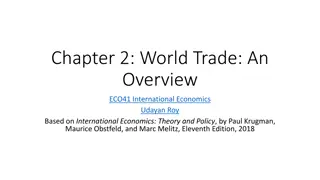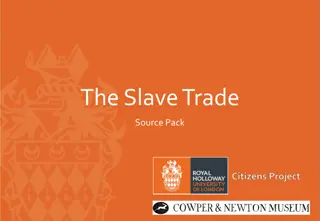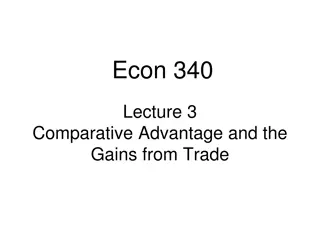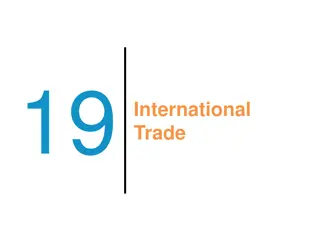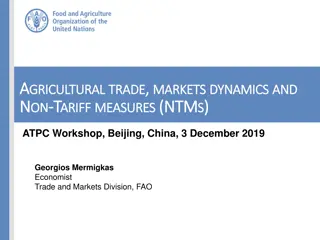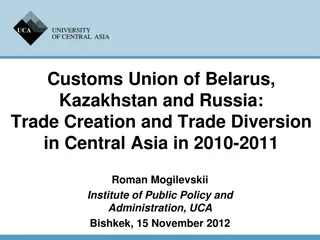The Atlantic Slave Trade and Its Impact
The Atlantic Slave Trade played a pivotal role in the economic development of the Americas by forcibly transporting Africans to work on plantations. This trade led to the separation of families, introduced new agricultural techniques, and contributed to the cultural blending of populations. The exploitation and suffering endured by enslaved individuals during the Middle Passage remains a dark chapter in history.
Download Presentation

Please find below an Image/Link to download the presentation.
The content on the website is provided AS IS for your information and personal use only. It may not be sold, licensed, or shared on other websites without obtaining consent from the author. Download presentation by click this link. If you encounter any issues during the download, it is possible that the publisher has removed the file from their server.
E N D
Presentation Transcript
Do Now Please stand behind my calendar desk ONLY Do not spill over either side. Those who are not behind the desk by the bell will be brought to ISS. Right here
Do Now continued What was the most uncomfortable way you have ever traveled?
Background European colonists tried to meet their labor needs by enslaving Native Americans or using indentured servants. death of millions of Native Americans from disease led to a chronic labor shortage Europeans turned to Africa. Enslaved Africans became part of the series of trading networks that exchanged goods for slaves and crisscrossed the American colonies, Europe, the Caribbean, and Africa. Portuguese settlement of Brazil Demand for slaves grew massively as Brazil s sugar industry expanded. African rulers Some African rulers helped deliver slaves to Europeans in exchange for goods. African merchants They bought and sold slaves. When African rulers opposed the slave trade, merchants developed new trade routes.
Atlantic Slave Trade The buying and selling of Africans for work in the Americas became known as the Atlantic Slave Trade. Triangular trade: carried manufactured goods to Africa, where they were exchanged for slaves. Slaves were carried to the Americas and exchanged for raw agricultural products, such as sugar, coffee, and tobacco, which were carried to Europe and sold. Middle passage: Captured Africans were transported under horrific conditions along the middle leg of the triangular trade routes.
Effects of Slave Trade population drain, introduction of guns that helped spread war and devastation separation from families, harsh lives. provided economic, cultural development, and farming expertise that helped many colonies survive. knowledgeable Africans introduced rice-growing techniques that made South Carolina a profitable rice producer. addition of Africans to population group, mixed-race populations, cultural additions, cultural blending
DBQ= Document Based Question Let s talk about evidence building and using sources cause your opinions are worthless For real Like for real real.
Frederick Douglass Started out life as a slave Abolitionist Sought out by President Lincoln for advising *He had a vacation home right here in Long Branch
Primary Source Document Analysis SOAPSTone OPTIC
Do Now #11 Where did the ingredients come from?
Analyzing Snickers Old world to New World Sugar - 1st discovered in India. Chickens - parts of Asia. Soybean - Korea. Cows - Asia, Europe & North Africa. New World to Old World Cocoa Peanuts
Background Colonization resulted in the exchange of new items. The new wealth from the Americas resulted in new business and trade practices for Europe. The global transfer of foods, plants and animals during colonization of the Americas is known as the Columbian Exchange named after Christopher Columbus. Two of the most important items to be brought to Europe was corn and potatoes, which were both inexpensive to grow and nutritious.
Pros & Cons of the Exchange Many of new animals and plants were introduced to both Europe and the Americas played a significant role in boosting populations. New products were manufactured using goods from both Europe and the Americas. Various diseases were brought to the Americas that Native Americans were not immune to resulting in many deaths. Slaves were traded more frequently because of the demand for American crops.
Capitalism & Stocks Capitalism: an economic system based on private owner-ship and investment for profit. Numerous merchants gained wealth & numerous businesses across Europe flourished. The increase in economic activity led to an increase in the money supply resulting in inflation. Inflation occurs when there is more money to spend thus demanding more goods - the price in goods then increases due to lack of supply to meet the demand. Joint-stock company: worked like a modern day cooperation, investors buy shares of stock to invest in a company. (pooling wealth for a common purpose)
Restaurant Activity Take out the name of the recipe that you looked into for homework Using the Internet please look up your recipe for the dish of your choice and write down the ingredients. Locate the country of origin in which you can find the ingredients and color code the map, listing the ingredients that you have imported from the country to make your dish. Make sure you include a key so we know what dish you are talking about. Your final product should be a color-coded map and ingredient list. Provided.





